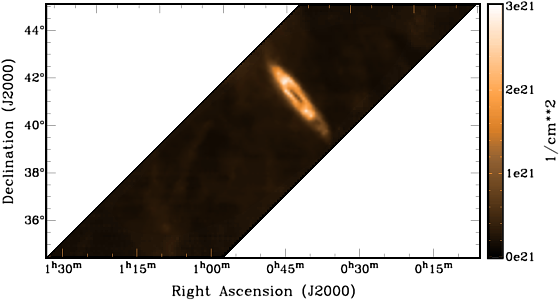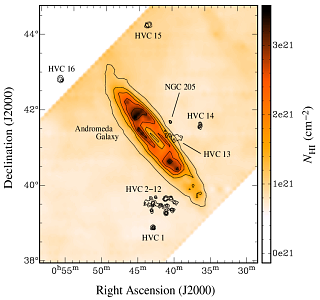Research
The high-velocity clouds of M31
Introduction
The major problem in HVC research is the unknown distance towards most of the HVCs. So far, accurate distance brackets have only been determined for parts of the HVC complexes C, M, and WB based on stellar absorption measurements. Distance, however, is the key parameter to determine the important physical properties of the HVCs such as their masses, densities, and sizes. Moreover, accurate distance measurements for the HVCs would provide us with a detailed picture of their radial distribution around the Galaxy, allowing us to constrain the origin of HVCs and to compare their spatial distribution with the results of ΛCDM structure formation scenarios.

One solution to the distance problem is the study the HVC populations of external galaxies. The nearest galaxy with a mass and size comparable to that of our own Milky Way is the Andromeda Galaxy (M31). Thilker et al. (2004) used the Green Bank Telescope (GBT) to map an area of 7° × 7° around M31 in H i. They discovered a population of HVCs located within a projected distance of about 50 kpc from M31. Models by de Heij, Braun & Burton (2002), however, suggest a spatial distribution of HVCs with a Gaussian dispersion of about 150 to 200 kpc around the Milky Way. Hydrostatic simulations by Sternberg, McKee & Wolfire (2002) also agree with a characteristic distance of 150 kpc. If these models were correct, we would expect to find more HVCs far beyond the boundaries of the area mapped by Thilker et al. (2004).
The Effelsberg blind survey of M31
To search for additional HVCs around M31, we conducted an H i blind survey of a large region around the Andromeda Galaxy, using the 100-m radio telescope at Effelsberg. The survey was performed between July 2003 and July 2004 and covers a total area of $15^{\circ} \times 5^{\circ}$ around M31, corresponding to a projected area of about $215 \times 65~\mathrm{kpc}^{2}$. Our observations could confirm most of the HVCs discovered near the disk of M31 by Thilker et al. (2004) with the Green Bank Telescope. But we failed to detect any additional HVCs beyond a projected distance of about $50~\mathrm{kpc}$ from M31 with a $3 \, \sigma$ H i mass detection limit of $6 \times 10^{4}~M_{\odot}$. One explanation for our non-detection could be that the proportion of ionised gas in the HVCs is growing with radial distance from M31 so that the HVCs outside $50~\mathrm{kpc}$ radius could not be observed in the 21-cm line any more. Another possibility is that HVCs are concentrated in the vicinity of their host galaxies. If we assume that the Milky Way and M31 have similar populations of HVCs we can use our non-detection to estimate an upper limit for the distance of HVCs from their central galaxies of about $60~\mathrm{kpc}$. This result places the HVCs much closer than previously thought and particularly closer than the $150~\mathrm{kpc}$ suggested by the models and simulations. Our results show that HVCs, including the CHVCs, are forming a circumgalactic population instead of being spread all across the Local Group.
Follow-up interferometric observations
 To further investigate the properties of the HVCs around M31, we performed high-resolution synthesis observations with the Westerbork Synthesis Radio Telescope (WSRT). The WSRT was pointed at 9 positions with conspicuous HVC emission in the GBT data of Thilker et al. (2004). In the framework of the 2004 ASTRON/JIVE summer school I had the opportunity to reduce and analyse the WSRT data. At an angular resolution of $2'$ we detect 16~individual HVCs with typical H i masses of a few times $10^{5}~M_{\odot}$ and linear sizes of about $1~\mathrm{kpc}$. Twelve HVCs are grouped in an area of $1^{\circ} \times 1^{\circ}$ close to the disk of M31. We consider these HVCs as a coherent HVC complex which might represent tidally disrupted gas associated with the giant stellar stream found by Ibata et al (2001). Tidal interaction might also be responsible for an HVC located near NGC 205. The remaining HVCs around M31 are isolated in position and velocity and may represent primordial, dark-matter-dominated clouds.
To further investigate the properties of the HVCs around M31, we performed high-resolution synthesis observations with the Westerbork Synthesis Radio Telescope (WSRT). The WSRT was pointed at 9 positions with conspicuous HVC emission in the GBT data of Thilker et al. (2004). In the framework of the 2004 ASTRON/JIVE summer school I had the opportunity to reduce and analyse the WSRT data. At an angular resolution of $2'$ we detect 16~individual HVCs with typical H i masses of a few times $10^{5}~M_{\odot}$ and linear sizes of about $1~\mathrm{kpc}$. Twelve HVCs are grouped in an area of $1^{\circ} \times 1^{\circ}$ close to the disk of M31. We consider these HVCs as a coherent HVC complex which might represent tidally disrupted gas associated with the giant stellar stream found by Ibata et al (2001). Tidal interaction might also be responsible for an HVC located near NGC 205. The remaining HVCs around M31 are isolated in position and velocity and may represent primordial, dark-matter-dominated clouds.
Publications for further reading
- Relics of structure formation: extra-planar gas and high-velocity clouds around the Andromeda Galaxy
Westmeier, T., Brüns, C. & Kerp, J. 2008, MNRAS, 390, 1691
(astro-ph/0808.3611) - Westerbork H i observations of high-velocity clouds near M31 and M33
Westmeier, T., Braun, R. & Thilker, D. 2005, A&A, 436, 101
(astro-ph/0503246)